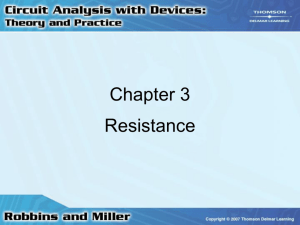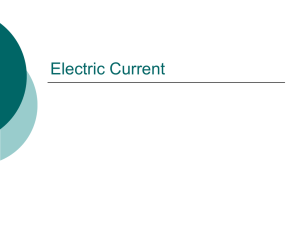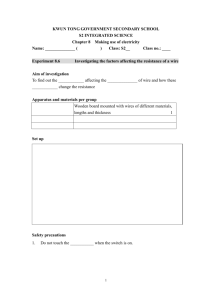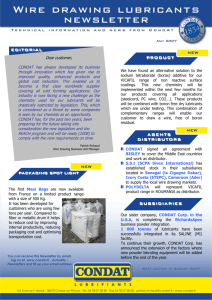Table 3-1 Resistivity of Materials
advertisement
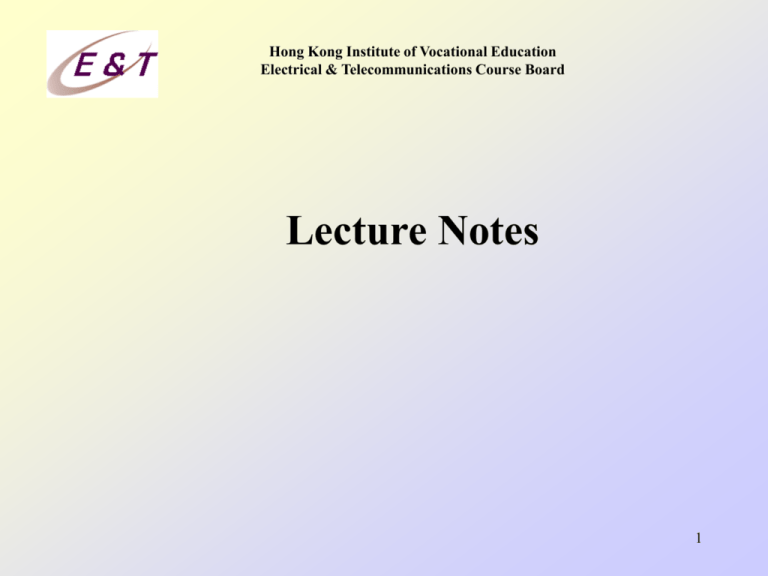
Hong Kong Institute of Vocational Education
Electrical & Telecommunications Course Board
Lecture Notes
1
Chapter 3 Resistance
Part 1
2
Course materials Web Sites Address
• Internet Address:
– http://webct.vtc.edu.hk
– User ID : rlc
– Password : cable
3
3.1 Resistance of Conductors (p. 60)
The resistance of a material is dependent upon several factors:
•
•
•
•
Type of materials
Length of the conductor
Cross-sectional area
Temperature
4
The factors governing the resistance of a conductor at a given
temperature:
l
R
A
where
ohms
= resistivity, in ohms-meters ( -m )[Table 3-1]
l = length, in meters (m)
A = cross-sectional area, in square meters (m2)
5
Table 3-1
Resistivity of Materials (p. 60)
MATERIAL
RESISTIVITY, ,
o
AT 20 C (-m)
___________________________________
Silver
1.645 x 10-8
Copper
1.723 x 10 -8
Gold
2.443 x 10 -8
Aluminum
2.825 x 10 -8
Tungsten
5.485 x 10 -8
Iron
12.30 x 10 -8
Lead
22 x 10 -8
Mercury
95.8 x 10 -8
Nichrome
99.72 x 10 -8
Carbon
3500 x 10 -8
Germanium
20 - 2300*
Silicon
500*
Wood
108 - 1014
Glass
1010 - 1014
Mica
1011 - 1015
Hard rubber
1013 - 1016
Amber
5 x 1014
Sulphur
1 x 1015
Teflon
1 x 1016
6
Example 3-1 (p. 61)
EXAMPLE 3-1
Most homes use solid copper wire having a di-ameter of 1.63mm
to provide electrical distribution to outlets and light sockets. Determine the resistance of
75 meters of a solid copper wire having the above diameter.
Solution
We will first calculate the cross-sectional area of the wire
using equation 3-2.
A= πd2/4
= π(1.63 x 10-3 m)2/4
= 2.09 x 10-6 m2
Now, using Table 3-1, the resistance of the length of wire is found as
R = ρl/A
= (1.723 x 10-8 Ωm)(75m)/2.09 x 10-6m2
= 0.619 Ω
7
Example 3 - 2 (p. 61)
8
Question:
Two copper wires with same volume has radius r1 and r2 respectively.
Find the ratio of their resistance.
Homework :
Practice Problem I
Learning Check I
9
Solution :
Two copper wires with same volume has radius r1 and r2 respectively. Find the
ratio of their resistance.
[ In Forms of R1, R2 (ohms) ]
R1
L1
A1
Same vol =>
R2
,
L2
A2
A1L1 = A2L2
or
L1
A
2
L2
A1
R1
L A
1 2
R2 L2 A1
2 2
A
r
22 2
A1
r12
2
Homework: Practice Problem I
Learning Check I
2
r
2
r1
4
10
3.2 Electrical Wire Table (p. 62)
• The American Wire Gauge (AWG) is the primary system used to
denote wire diameters.
• In this system, each wire diameter is assigned a guage number. The
higher the AWG number, the smaller the diameter of the cable or
wire.
Question: For a given length of aWG 22 gauge-wire and a given length
of AWG 14 gauge-wire, which one has larger resistance?
11
Table 3-2 (p. 63)
12
3.3 Resistance of Wires - Circular Mils
(p. 65)
1 mil = 0.001 inch
•
The American Wire Gauge system for specifying wire diameterts
was developed using a unit called the circular mil (CM), which is
defined as the area contained within a circle having a diameter of 1
mil.
•
The greatest advantage of using the circular mil to express areas of
wires is the simplicity with which calculations may be made. A
wire which has diameter d expressed in mils has an area in circular
given as
•
ACM = dmil2
[ circular mils, CM ]
13
• The cross-sectional area of a cable may be a large number when it is
expressed I circular mils. The Roman numeral M is often used to
represent 1000. If a wire has a cross-sectional area of 250 000 CM, it
is written as 250 MCM.
• Note that it is different from the SI unit, M represents 1 million.
Assignment : (Ch.3)
Problem 1, 5, 7, 11
14
3.4 Temperature Effects (p. 69)
• Resistance of a conductor is not constant at all temperature.
• As temperature increasers, more electrons will escaoe their orbits,
causing additional collisions within the conductors. For most
conducting materials, the increase in the number of collisions
translates into an icnrease in resistance.
• The rate at which the resistance of a material changes with a variation
in temperature is called the temperature coefficient of the material
( ). [Fig. 3.6]
15
Fig. 3-6 Temp effects on the resistance of a conductor (p. 69)
16
• Resistance of any material increases as temp increases - positive temp coefficient.
• For semiconductor materials, increases in temp allow electrons to escape their usually
stable orbits and become free to move within the material - negative temp coefficient.
[Table 3.4, p. 70]
TABLE 3-4 Temperature Intercepts and Coefficients for Common Materials
T
(oC)-1
(oC)-1
(oC)
AT20oC
AT 0oC
_____________________________________________________________
Silver
-243
0.003 8
0.004 12
Copper
-234.5
0.003 93
0.004 27
Aluminum
-236
0.003 91
0.004 24
Tungsten
-202
0.004 50
0.004 95
Iron
-162
0.005 5
0.006 18
Lead
-224
0.004 26
0.004 66
Nichrome
-2270
0.000 44
0.000 44
Brass
-480
0.002 00
0.002 08
Platinum
-310
0.003 03
0.003 23
Carbon
-0.000 5
Germanium
-0.048
Silicon
-0.075
17
From Fig. 3-6, slope of the line
m = R/ T
= (R1 - 0) / (T1 - T) [unit : / oC]
Define temp. coefficient as
1 = m / R1 [unit: (oC)-1]
Question: What is the sign (+ve or -ve) of the slope, m, for
a) copper?
b) silicon?
18
• The temp coefficient will not be cosntant everywhere but is dependent
upon the resistance R1 and temp.
R2 = R1 + m T
=R1 + m (T2 - T1)
= R1 [ 1 + (m/R1)(T2 - T1)]
R2 = R1 [ 1 + (1)(T2 - T1)]
19
EXAMPLE 3-8 (p. 71)
An aluminum wire has a resistance of 20 at room temperature (20
C). Calculate the resistance of the same wire at temperatures of –
40 C, 100 C, and 200 C.
Solution
At –40 C:
From Table 3-4, we see that aluminum has a temperature coefficient
of = 0.00391. The resistance at –40 C is now determined to be
`R –40 C = (20 ){1 + [0.00391(C) –1] [–40 C –20 C]}
= 15.3
[Learning Check IV]
20
